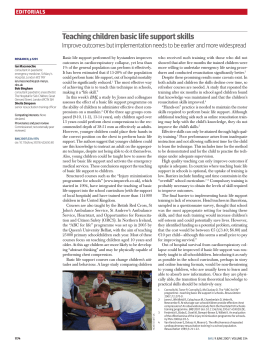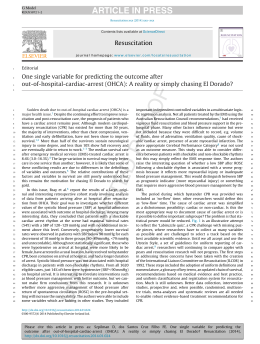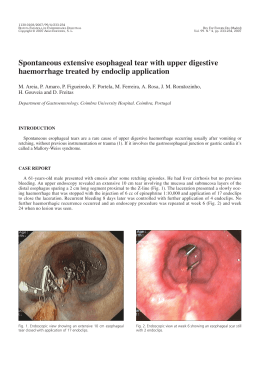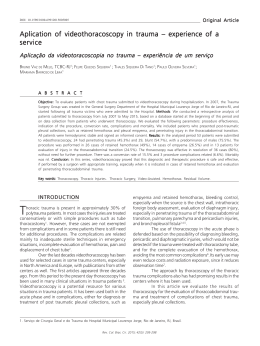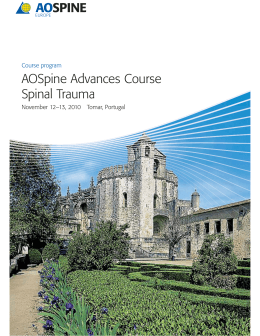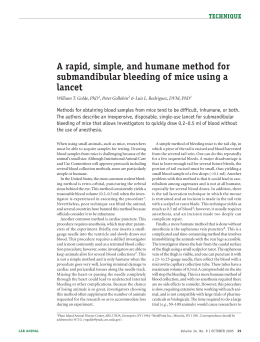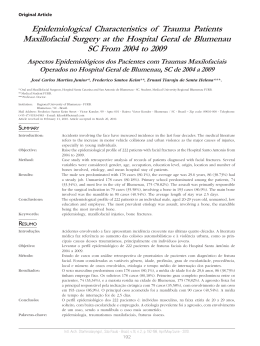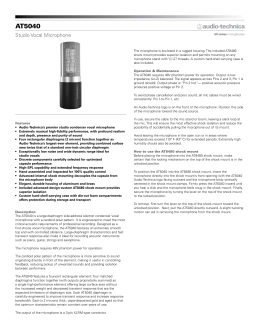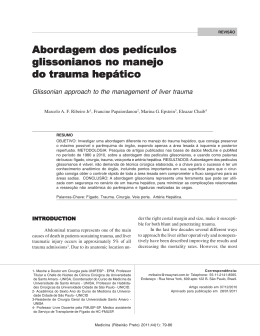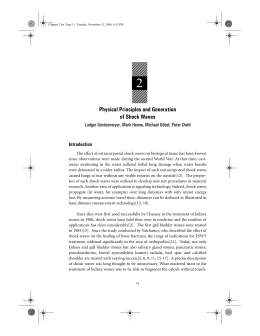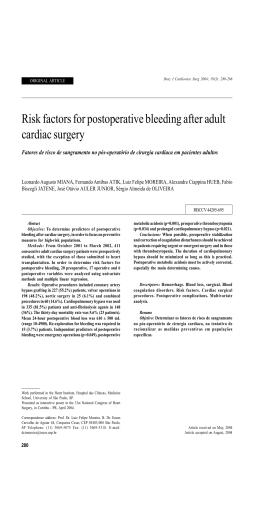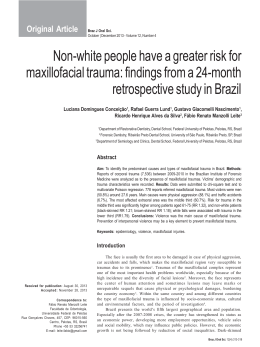REVIEW ARTICLE Permissive hypotension in trauma Hipotensão permissiva no trauma Paulo Roberto Lima Carreiro1 DOI: 10.5935/2238-3182.20140144 ABSTRACT 1 MD. Surgeon. Doctor in Surgery. Professor at the Medical School of the José do Rosário Vellano University – Unifenas. Surgeon at the João XXIII Hospital from the State of Minas Gerais Hospital Foundation – FHEMIG. Belo Horizonte, MG – Brazil. Hemorrhagic shock is one of the leading causes of preventable deaths in trauma cases. Current treatment protocols acknowledge the importance of the early approach of coagulopathy related to trauma and that the infusion of large volumes of crystalloids is harmful to patients. The quick bleeding control is still the most important measure in the treatment of hemorrhagic shock. Thus, the permissive hypotension is a strategy increasingly being used in the resuscitation of patients with traumatic bleeding. In this article, we conducted a literature review with a critical analysis of indications for permissive hypotension in trauma. Key words: Wounds and Injuries; Shock, Hemorrhagic; Resuscitation. RESUMO O choque hemorrágico é uma das principais causas de mortes evitáveis no trauma.Os protocolos atuais de tratamento reconhecem a importância da abordagem precoce da coagulopatia relacionada ao trauma e que a infusão de grandes volumes de cristaloides são prejudiciais aos pacientes. O controle rápido do sangramento continua sendo a medida mais importante no tratamento do choque hemorrágico. Neste contexto, a hipotensão permissiva é uma estratégia cada vez mais utilizada na reanimação de pacientes com hemorragias traumáticas. Neste artigo realizamos uma revisão da literatura com uma análise crítica das indicações da hipotensão permissiva no trauma. Palavras-chave: Ferimentos e Lesões; Choque Hemorrágico; Ressuscitação. INTRODUCTION Submitted: 2014/08/09 Approved: 2014/10/11 Institution: João XXIII Emergency Room Hospital Belo Horizonte, MG – Brazil Corresponding Author: Paulo Roberto Lima Carreiro E-mail: [email protected] 498 Trauma is the leading cause of death in the population up to 40 years of age, and the disease with the greatest impact on reducing the life expectancy of the world’s population. The hemorrhagic shock is responsible for 30 to 40% of deaths from trauma, consisting of the most common cause of potentially preventable deaths. Approximately 50% of patients, who die during the first 24 hours after trauma, have hemorrhage as the cause of death.1 The quick control of bleeding is the most effective measure to approach the patient with hemorrhagic shock. Post-traumatic bleeding treatment protocols emphasize the rapid restoration of tissue perfusion through the infusion of large volumes of crystalloids such as 0.9% saline solution or lactated ringer.2 This conduct raises the blood pressure (BP) and, if implemented before the surgical control of bleeding, causes the rupture of blood clots formed in injured vessels and could result in Rev Med Minas Gerais 2014; 24(4): 498-502 Permissive hypotension in trauma re-bleeding.3 Other mechanisms that could lead to increased bleeding through the infusion of crystalloids are the dilution of coagulation factors, increased blood pressure, acidosis, and hypothermia.4 Currently, coagulopathy is considered the primary event in trauma; up to 30% of patients with severe bleeding arrive at the hospital with an installed clotting disorder even before receiving large volumes of liquids or being hypothermic.5 This clinical picture is called acute traumatic coagulopathy and would be correlated, among other factors, to the inflammatory response triggered by trauma and shock. The lesion and tissue hypoperfusion interfere in the processes of coagulation and favor fibrinolysis and consumption of fibrinogen by the activation of protein C.6 Therefore, the current strategies to treat hemorrhagic shock aim at, in addition to the quick control of bleeding and perfusion restoration, an early approach to coagulopathy. In this current context, which recognizes the deleterious effects of an excessive crystalloid administration and values the importance of the early treatment of coagulopathy, the permissive hypotension is the increasingly studied and recommended conduct. REVIEW OF THE LITERATURE The volemic reposition, started only after the hemorrhage control in patients with active bleeding, was advocated in 1918. The rationale for this conduct was based on the fear that the excessive infusion of fluids could result in increased bleeding.7 This hypothesis was confirmed by studies in animal models (dogs, pigs, sheep), which showed an increase of bleeding in the treatment of hemorrhagic shock by aggressive volemic reposition. More careful volume infusions reduced mortality.8-12 A research involving 598 patients victims of penetrating trauma to the torso and hypotension (systolic arterial pressure-SAP < 90 mmHg) emphasized that patients who received normotensive volemic reposition from the pre-hospital stage had worsen survival outcomes (62% vs. 70%, p < 0.04), higher rates of complications, and longer hospital stay than the group in which the volemic reposition was only initiated after the surgical control of bleeding. Despite that the resuscitation strategy used (delayed volemic resuscitation) is different from the concept of permissive hypotension, this study proved that the concept of prevailing aggressive volemic resuscitation does not seem to be essential in the treatment of hemorrhagic shock.13 Another prospective clinical study, using 55 patients with normotensive resuscitation (SAP > 110 mmHg) and 55 patients reanimated with permissive hypotension (SAP < 70 mmHg), found no difference in mortality rates between the groups. Patients with traumatic brain injury (TBI) were excluded.14 A prospective multicenter study involving 1,754 patients demonstrated that the amount of fluids infused in the first 24 hours was directly related to the incidence of complications, mainly with adult respiratory distress syndrome and abdominal compartment syndrome. The aggressive volemic resuscitation was also associated with longer hospital stay and hospitalization in the intensive care unit. A relationship between the volume of fluid administered and mortality rate was not detected in this study.15 A prospective and randomized study evaluated the effects of permissive hypotension and normotensive resuscitation in the treatment of victims of penetrating and blunt trauma. The patients in the group with permissive hypotension (average blood pressure = 50 mmHg) had lower mortality rates in the immediate post-operative period, less tendency to develop coagulopathy, and received the least amount of blood products. This was a preliminary analysis with a sample of 90 patients and prevalence of patients with blunt trauma and severity index (Injury Severity Score-ISS) greater in the group of normotensive resuscitation.16 A limitation is described related to the approach of permissive hypotension in patients with traumatic brain injury (TBI). In these patients, the lowest pressure levels could reduce the cerebral perfusion pressure and, consequently, contribute to the installation or worsening of secondary brain injuries.17 The maintenance of cerebral perfusion pressure above 70 mmHg reduced mortality in patients who are victims of TBI.18 The evaluation of tissue perfusion with microspheres in an uncontrolled hemorrhage model in rats showed that permissive hypotension reduced intraabdominal bleeding without impairment of tissue perfusion, including the brain.19 Several investigations about strategies of volemic reposition in animal models also revealed that an aggressive volemic resuscitation is associated with increased bleeding. A study with an uncontrolled bleeding canine model showed that the increase in infused volume was associated with increased bleeding.8 Another research using a pig model concluded Rev Med Minas Gerais 2014; 24(4): 498-502 499 Permissive hypotension in trauma that the rapid restoration of blood pressure from crystalloid infusion resulted in increased bleeding and mortality.9 The most judicious volume infusion reduced mortality when compared to animals that received larger amounts of liquids.10 Other studies using uncontrolled hemorrhagic shock models in sheep independently found a direct relation between the infused volume and level of increase in blood pressure, amid the occurrence of adverse effects and increased mortality.11,12 A systematic review involving 52 experimental studies and 2,039 animals using shock models with more serious hemorrhages (aortic lesions or sections of more than 50% from the tail) showed that the infusion of liquids reduced the risk of death compared to the absence of infusion. In models with less serious bleeding (lesions of vessels other than the aorta, or sections smaller than 50% from the tail), the liquid infusion increased mortality. In these animals, the potential risks associated with the infusion of fluids seem to overcome the possible benefits of increased blood pressure and tissues perfusion. Nine of these studies compared permissive hypotension with normotensive volemic reposition. Permissive hypotension reduced the risk of death in all of them.20 A study on an uncontrolled shock model in rats reported that the excessive administration of lactated ringer was associated with worsening of coagulation parameters and a significant increase in bleeding. Still in this study, higher values of hematocrit correlated with better indices of coagulation.21 A retrospective clinical study, in which more than 3 liters of crystalloids or 500 mL of colloid were administered during abdominal surgeries, was also associated with postoperative coagulopathy.22 DISCUSSION Since the 60s, the resuscitation of patients victims of trauma in shock is based on aggressive volemic reposition with crystalloids.23 This conduct was driven by the experience gained in the Viet Nam war and reinforced in the 80s by the concept of supranormal resuscitation.24 This resuscitation strategy based on an excessive crystalloid infusion was also advocated by the protocol of the Advanced Trauma Life Support (ATLS®) in its early editions.2 In fact, although there are no prospective randomized clinical studies, the use of volemic resuscitation aiming to normalize 500 Rev Med Minas Gerais 2014; 24(4): 498-502 blood pressure with the infusion of large volumes of liquids predominated in the last 50 years. The deleterious effects of an aggressive volemic reposition are well-known, and various complications are described: adult respiratory distress syndrome, abdominal compartment syndrome, cerebral edema, and cardiac dysfunction among others.25 The excessive infusion of liquids may result in increased bleeding by the following mechanisms: increased blood pressure (BP), dilution of coagulation factors, reduction of blood viscosity, and installation or aggravation of hypothermia. All of these factors negatively interfere with coagulation and are associated with the pathophysiology of trauma-induced coagulopathy.4,5 Another explanation for the increase in bleeding associated with normotensive volemic resuscitation is that a rapid infusion of large volumes of crystalloids provokes the displacement of clots adhered on the site of vascular lesion, removing the initial cap formed by platelets and fibrin (primary coagulation) and favoring re-bleeding.3 Patients with gastrointestinal bleeding due to esophageal varices are typically maintained at lowpressure levels aiming to decrease the possibility of re-bleeding. Therefore, it seems logical to adopt this same strategy to patients who are victims of trauma. Resuscitation strategies that limit liquid infusion in patients with uncontrolled bleeding aimed at offering enough volume to maintain adequate tissue perfusion without causing increased bleeding. However, the adequate blood pressure levels to achieve these goals are not yet defined.26 A study on an experimental uncontrolled shock model in mice used different levels of mean arterial pressures with the goal of volemic resuscitation (40, 50, 60, 70, 80, and 100 mmHg). The animals undergoing normotensive resuscitation (80 and 100 mm Hg) had more bleeding, organ dysfunction, and higher mortality rate than those undergoing permissive hypotension (50 and 60 mmHg). The reanimated animals with the medium pressure of 40 mmHg had less bleeding, however, at the expense of increased organ dysfunction and mortality. The time of permissive hypotension tolerance in this study was of 90 minutes. The mortality rate increased after this time.27 A question to be considered is the shortage of prospective and randomized clinical studies to definitively assess the possible benefits of permissive hypotension. Most of the studies are experimental and with their typical limitations. Among the main Permissive hypotension in trauma limitations is the fact that in these experimental models the animals are anesthetized and do not show the adrenergic response that are present in patients in hemorrhagic shock. Another limitation is that, in most cases, small rodents or rabbits are used, which have coagulation systems different from humans. There is great difficulty in developing models that can simulate the complex interactions between tissue lesion, shock, and coagulation.28,29 There is a tendency in the literature to restrict the volume of fluids infused in the reanimation of patients with uncontrolled bleeding. The ATLS® protocol, in its last edition, recommends the reduction of the initial dose of crystalloids from 2,000 mL to 1,000 mL, and suggests a fluid reposition that is less aggressive than that recommended in its previous editions.30 CONCLUSIONS Clinical and experimental studies demonstrate that an excessive fluid administration is related to increased bleeding, complications, and deaths. Despite the tendency of the current protocols to recommend the judicious use of crystalloids in volemic resuscitation of trauma victims, controlled and prospective studies are still required to define the appropriate pressure levels and maximum use of permissive hypotension in patients with hemorrhagic shock. REFERENCES 1. Kauvar DS, Lefering R, Wade CE. Impact of hemorrhage on trauma outcome: an overview of epidemiology, clinical presentations, and therapeutic considerations. J Trauma. 2006; 60(6 Suppl):S3-11. 2. American College of Surgeons. Advanced trauma life support course. 7th ed. Chicago: ACS; 2001. 3. Sondeen JL, Coppes VG, Holcomb JB. Blood pressure at which rebleeding occurs after resuscitation in swine with aortic injury. J Trauma. 2003; 54(5 Suppl):S110-7. 4. Spinella PC, Holcomb JB. Resuscitation and transfusion principles for traumatic hemorrhagic shock. Blood Rev. 2009; 23(6):231-40. 5. Brohi K, Singh J, Heron M, Coats T. Acute traumatic coagulopathy. J Trauma. 2003; 54(6):1127-30. 8. Shaftan GW, Chiu CJ, Dennis C, Harris B. Fundamentals of physiologic control of arterial hemorrhage. Surgery. 1965; 58(5):851-6. 9. Stern SA, Dronen SC, Birrer P, Wang X. Effect of blood pressure on hemorrhage volume and survival in a near-fatal hemorrhage model incorporating a vascular injury. Ann Emerg Med. 1993; 22(2):155-63. 10. Capone AC, Safar P, Stezoski W, Tisherman S, Peitzman AB. Improved outcome with fluid restriction in treatment of uncontrolled hemorrhagic shock. J Am Coll Surg. 1995; 180(1):49-56. 11. Krausz MM, Bashenko Y, Hirsh M. Crystalloid and colloid resuscitation of uncontrolled hemorrhagic shock following massive splenic injury. Shock. 2001; 16(5):383-8. 12. Solomonov E, Hirsh M,Yahiya A, Krausz MM. The effect of vigorous fluid resuscitation in uncontrolled hemorrhagic shock after massive splenic injury. Crit Care Med. 2000; 28(3):749-54. 13. Bickell WH, Wall MJ Jr, Pepe PE, Martin RR, Ginger VF, Allen MK, et al. Immediate versus delayed fluid resuscitation for hypotensive patients with penetrating torso injuries. N Engl J Med. 1994; 331(17):1105-9. 14. Dutton RP, Mackenzie CF, Scalea TM. Hypotensive resuscitation during active hemorrhage: impact on in-hospital mortality. J Trauma. 2002; 52(6):1141-6. 15. Kasotakis G, Sideris A,Yang Y, de Moya M, Alam H, Inflammation and host response to injury investigators. Aggressive early crystalloid resuscitation adversely affects outcomes in adult blunt trauma patients: an analysis of the Glue Grant database. J Trauma Acute Care Surg. 2013; 74(5):1215-22. 16. Morrison CA, Carrick MM, Norman MA, Scott BG, Welsh FJ, Tsai P, et al. Hypotensive resuscitation strategy reduces transfusion requirements and severe postoperative coagulopathy in trauma patients with hemorrhagic shock: preliminary results of a randomized controlled trial. J Trauma. 2011; 70(3):652-63. 17. Chesnut RM, Marshall SB, Piek J, Blunt BA, Klauber MR, Marshall LF. Early and late systemic hypotension as a frequent and fundamental source of cerebral ischemia following severe brain injury in the Traumatic Coma Data Bank. Acta Neurochir Suppl (Wien). 1993; 59:121-5. 18. Rosner MJ, Daughton S. Cerebral perfusion pressure management in head injury. J Trauma. 1990; 30(8):933-41. 19. Schmidt BM, Rezende Neto JB, Andrade MV,Winter PC, Carvalho MG Jr, Lisboa TA, et al. Permissive hypotension does not reduce regional organ perfusion compared to normotensive resuscitation: animal study with fluorescent microspheres.World J Emerg Surg. 2012; 7(Suppl 1):S9. 20. Mapstone J, Roberts I, Evans P. Fluid resuscitation strategies: a systematic review of animal trials. J Trauma. 2003; 55(3):571-89. 21. Nishi K,Takasu A, Shinozaki H,Yamamoto Y, Sakamoto T. Hemodilution as a result of aggressive fluid resuscitation aggravates coagulopathy in a rat model of uncontrolled hemorrhagic shock. J Trauma Acute Care Surg. 2013; 74(3):808-12. 6. Davenport R. Pathogenesis of acute traumatic coagulopathy. Transfusion. 2013; 53(Suppl 1):23S-27S. 22. Barak M, Rudin M,Vofsi O, Droyan A, Katz Y. Fluid administration during abdominal surgery influences on coagulation in the postoperative period. Curr Surg. 2004; 61(5):459-62. 7. Cannon WB, Fraser J, Cowel EM. The preventive treatment of wound shock. JAMA. 1918; 70(9):618-21. 23. Shires T, Coln D, Carrico J, Lightfoot S. Fluid therapy in hemorrhagic shock. Arch Surg. 1964; 88:688-93. Rev Med Minas Gerais 2014; 24(4): 498-502 501 Permissive hypotension in trauma 24. Shoemaker WC, Appel PL, Kram HB, Waxman K, Lee TS. Prospective trial of supranormal values of survivors as therapeutic goals in high-risk surgical patients. Chest. 1988; 94(6):1176-86. 27. Li T, Zhu Y, Hu Y, Li L, Diao Y, Tang J, Liu L. Ideal permissive hypothension to resuscitate uncontrolled hemorrhagic shock and tolerance time in rats. Anesthesiology. 2011; 114:111-9. 25. Cotton BA, Guy JS, Morris JA Jr, Abumrad NN. The cellular, metabolic, and systemic consequences of aggressive fluid resuscitation strategies. Shock. 2006; 26(2):115-21. 28. Rixen D, Neugebauer EAM. Changing paradigms in animal models of traumatic/hemorrhagic shock: a critical appraisal. Eur J Trauma. 2004; 30(5):279-88. 26. Ertmer C, Kampmeier T, Rehberg S, Lange M. Fluid resuscitation in multiple trauma patients. Curr Opin Anaesthesiol. 2011; 24(2):202-8. 29. Siller-Matula JM, Plasenzotti R, Spiel A, Quehenberger P, Jilma B. Interspecies differences in coagulation profile. Thromb Haemost. 2008; 100(3):397-404. 30. American College of Surgeons. Advanced trauma life support course. 9th ed. Chicago: ACS; 2012. 502 Rev Med Minas Gerais 2014; 24(4): 498-502
Download
